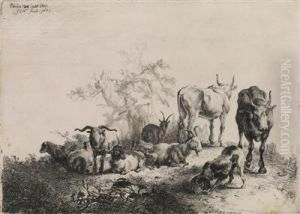Johannes Van Noordt Paintings
Johannes van Noordt was a Dutch painter and musician whose life and work were embedded in the rich artistic milieu of the 17th century in the Netherlands, a period often referred to as the Dutch Golden Age. Born in Amsterdam in 1620, van Noordt was part of a family deeply involved in the arts; his father, Pieter Nieuwlandt (or van Noordt), was a painter, and his brother, Jacob van Noordt, was an accomplished organist and composer.
Johannes van Noordt was primarily known for his work as a painter, and he specialized in biblical scenes and portraits. His style is characterized by a strong use of chiaroscuro, the dramatic contrast between light and shadow, which was influenced by the tenebrism of Caravaggio and his followers. Despite this Italian influence, van Noordt's work remained distinctly Dutch in its attention to detail and its sober, often moralistic tone.
Unfortunately, not much is known about van Noordt's training or early career. It is believed that he was a pupil of the painter Jacob Adriaensz Backer, given the stylistic similarities between their works. Van Noordt's paintings are relatively rare, which has made it difficult for art historians to trace his development or to establish a comprehensive oeuvre. One of his most notable works is the 'Portrait of a Young Man', which showcases his skill in capturing the textures of fabrics and the subtleties of human expression.
The details of Johannes van Noordt's personal life are also largely unknown, including information about possible patrons or his involvement in artists' guilds. He seems to have spent his entire life in Amsterdam, where he contributed to the city's burgeoning art scene. Van Noordt died in Amsterdam in 1676, leaving behind a modest but respected body of work that has captured the interest of art historians and collectors alike.
Because of the scarcity of his paintings and the lack of comprehensive historical records, Johannes van Noordt has not been as widely recognized as some of his contemporaries. However, his work provides valuable insight into the diversity of styles and subjects that flourished in Dutch painting during the 17th century. His legacy persists through the paintings that survive him, which continue to be studied and appreciated for their contributions to the era's artistic achievements.
